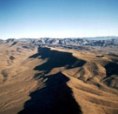
DOE Applies to Construct High-Level Nuclear Waste Repository in Nevada
The Nuclear Regulatory Commission received an application June 3 from the U.S. Department of Energy for a license to construct the nation's first geologic repository for high-level nuclear waste at Yucca Mountain, Nev. The site is located in a remote desert on federally protected land within the secure boundaries of the Nevada Test Site in the state's Nye County. It is approximately 100 miles northwest of Las Vegas, Nev.
DOE began studying the Nevada site in 1978 to determine whether it would be suitable for the nation's first long-term geologic repository for spent nuclear fuel and high-level radioactive waste. Currently stored at 126 sites around the nation, these materials are a result of nuclear power generation and national defense programs. On July 23, 2002, President Bush signed House Joint Resolution 87, allowing the DOE to take the next step in establishing a safe repository in which to store the nation's nuclear waste.
"We are ready to get to work on this challenging review," said NRC Chairman Dale E. Klein. "Congress has given the NRC a strict timetable for reviewing this application, and I want to assure the American people that we will perform an independent, rigorous and thorough examination to determine whether the repository can safely house the nation's high-level waste. The NRC's licensing decision will be based entirely on the technical merits."
The NRC has now begun a docketing review to determine whether the application is sufficiently complete to initiate a formal licensing review. If the application is deemed sufficiently complete, the agency will formally docket the application and publish a notice of opportunity to request a hearing before the Commission's Atomic Safety and Licensing Board. A decision to docket the application for review would not preclude the NRC from requesting additional information or documentation from DOE during the review. If the NRC dockets the application, it will announce at that time the extent to which it will adopt DOE's Final Environmental Impact Statement for the proposed repository.
Formal docketing of the application will trigger a three-year schedule set by Congress for NRC to determine whether to authorize construction. Congress has given the Commission an option to request a one-year extension, and the agency expects to need a fourth year. The NRC says it expects to meet this schedule, subject to Congress providing sufficient resources in a timely manner.
NRC's review is expected to involve more than 100 staff and contractor employees with expertise in several scientific disciplines, including geochemistry, hydrology, climatology, structural geology, volcanology, seismology, health physics, security, and law, as well as chemical, mechanical, nuclear, mining, materials, and geological engineering. Staff at NRC's headquarters in Rockville, Md., the Region IV office in Arlington, Texas, and the NRC's Las Vegas office will participate. The Center for Nuclear Waste Regulatory Analysis in San Antonio, Texas, a federally funded research and development center, will provide technical assistance to the Commission, as well.
The NRC’s Office of Nuclear Material Safety and Safeguards, under the direction of Michael F. Weber, will conduct the licensing review. Within that office, the Division of High-Level Waste Repository Safety will oversee daily operations for the review. The ASLB Panel includes 16 full-time judges with legal and technical expertise, and is headed by Chief Judge E. Roy Hawkens. The panel expects several boards of three judges each to be formed to conduct multiple hearings regarding the Yucca Mountain application. Potential parties to these hearings indicated earlier this year they intend to file as many as 650 contentions. Many of the hearing proceedings will be conducted at the NRC’s Las Vegas Hearing Facility, with others held at agency headquarters.
NRC's Licensing Support Network was created as an online library to facilitate the hearing process by providing the public and potential hearing parties early access to documents related to the application, as well as the application itself. The network is available through NRC's Web site and at http://lsnnet.gov/. More information about the NRC’s role in regulating the disposal of high-level nuclear waste is available on the NRC Web site at www.nrc.gov/waste/hlw-disposal.html.